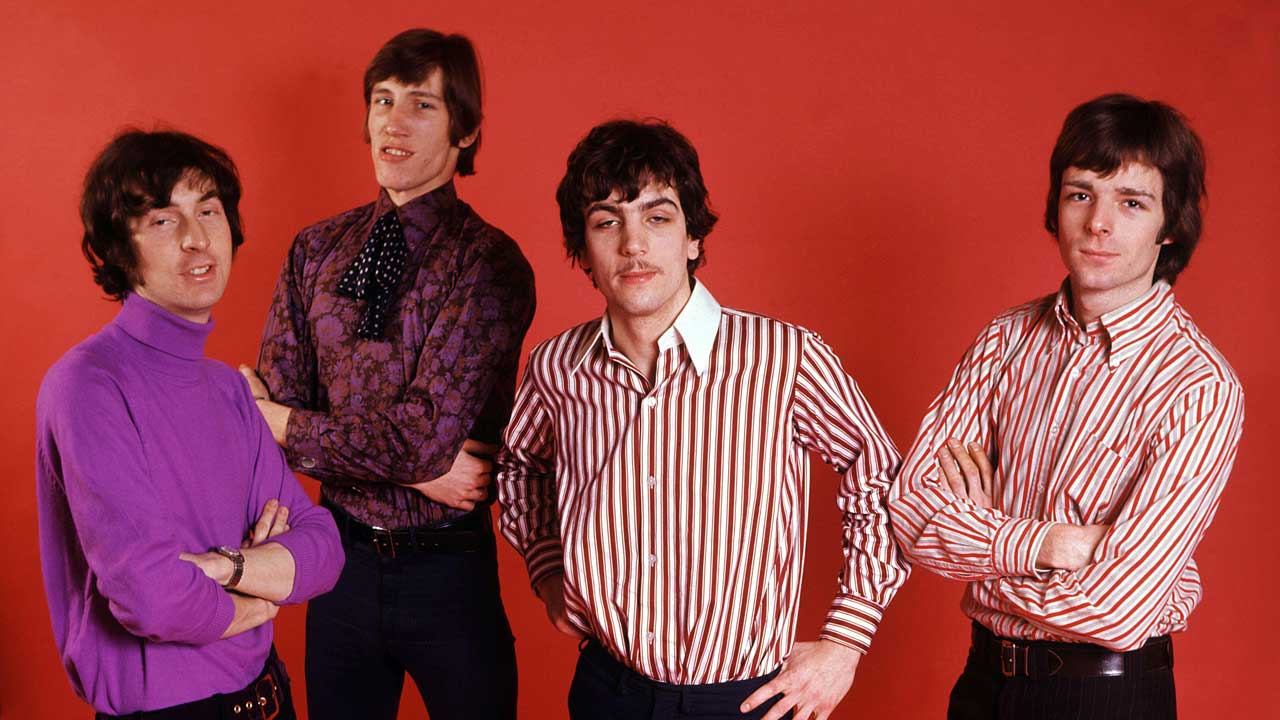
To quote Lee Harris, guitarist with Nick Mason’s Saucerful Of Secrets: “You can’t ignore Syd Barrett. It’s where Floyd’s story all starts.”
The talented but troubled Pink Floyd co-founder is certainly celebrated by Nick Mason’s group, now on their seventh tour in six years, with the Barrett-written See Emily Play in their setlist since day one, in May 2018. Despite its popularity, that was the first time Emily had been played live by a Pink Floyd member since 1968.
The roots of the song go back to the Floyd of 1966, when the group – Barrett, Nick Mason, Rick Wright and Roger Waters – were feeling their way as an experimental rock band, soundtracking the lift-off of LSD and psychedelia. The setlists Mason says, were initially “top twenty songs and R&B, with extended improvisations”. Soon, however, it was more original material, prompted by Barrett, worked into longer pieces.
Within a year – and thanks to being “in the right place at the right time”, says Mason – this avant-garde entity would have a mentor in American producer and promoter Joe Boyd, an important agent, Bryan Morrison, and a major record deal with EMI as word spread about the underground psychedelic scene. Floyd’s first single, Arnold Layne, reached No.20 in the UK four weeks after its release in April 1967.
Did entering the mainstream world jar with the band?
“We couldn’t care less,” Mason says today, laughing. “I suspect we just wanted to be on Top Of The Pops. We understood the way it worked, which was that you made singles, and if that went well you’d make an album. That was all about to change, of course, as albums would start to take off.”
Arnold Layne was recorded at Sound Techniques studio in London under Joe Boyd, but the next session would be brought further under the EMI umbrella, moving between Sound Techniques and Abbey Road, where the band were “bequeathed Norman Smith, the engineer for The Beatles, as producer”, says Mason. “They gave us a George Martin type of figure, and Norman helped us explore the studio and all it could do.”
The band had already recorded some tracks that would make up their debut LP, The Piper At The Gates Of Dawn, and their guitarist/frontman Barrett was leading the way with songwriting, storytelling and artistic feel.
An ambitious multimedia-driven free concert by Floyd at London’s Queen Elizabeth Hall, under the banner Games For May, had taken place, and Barrett’s See Emily Play was premiered there, its lyrics referencing the event (‘You’ll lose your mind and play, free games for May’). At the event, there were lights, films, and free daffodils handed out to the audience – a move that, bizarrely, got the group banned from the venue for life. “Some concert venues were unbelievably hostile to rock groups back then,” Mason says.
Mason’s memories of the songwriting process for Emily are hazy, but he recalls Barrett scribbling lyrics and playing melodies to the rest of the group on acoustic guitar.
“Back then we didn’t have a clear way of working, but we’d collaborate once presented with an idea and improvise until we got a song,” he says. “Syd was prolific, and the subjects and sounds were a curious mix, but we were really happy to try anything. It was so interesting that Syd would write something folky like The Scarecrow but also have a load of ideas and sounds to put into Interstellar Overdrive.”
See Emily Play was a consummate slice of British psych-pop whimsy, Barrett placing a mysterious female protagonist at the centre of his storytelling, to a stomping backing. Abbey Road provided a mix of traditional instruments for classical music, from piano to timpani, to wind machines and emerging electronic effects, such as delays and echo, built by engineers. The Beatles were recording Sgt Pepper’s at the same time; it was inevitable that an impression would be made on the already experimental Floyd.
From an originally much longer track, Smith and Boyd helped to create a radio-friendly song shape for Emily, with delightfully quirky touches such as Barrett’s Zippo-lighter slide-guitar playing, and the double-time piano part between verses, which Mason reveals was “all Joe’s invention. He’d be working away after the recording session”.
The identity of ‘Emily’ is much debated, with 15-year-old UFO-goer, friend of Barrett and ‘psychedelic schoolgirl’ Emily Young (daughter of Labour minister Wayland Young and writer-commentator Elizabeth Young) being the most likely fit. Barrett’s girlfriend Jenny Spires also noted that Emily was one of his favourite names “and he used to say: ‘If I ever have a daughter I want to call her Emily.’ ‘Emily’ was Syd’s Alice [In Wonderland].”
Following its release, on June 16, 1967, See Emily Play was quickly championed by radio stations. Escalating sales brought that longed-for TV appearance on Top Of The Pops. Unsurprisingly, this platform led to more sales and more appearances, which Barrett eventually balked at, saying: “John Lennon doesn’t have to do this, why should I?”
Around that time, the already unpredictable Barrett was exhibiting personality changes, which began his separation from the band.
“It’s guesswork what happened,” says Mason. “It might have been a breakdown, the use of LSD… I think he wanted to go back to painting.”
Today the mood of Emily is somehow ghostly, a shroud imprint of Barrett.
“The attraction of Emily is that, in some ways, it’s a jolly pop song,” says Mason. “But then there’s a slightly blue mood about it, the minor key. ‘Wistful’ is the word.”







